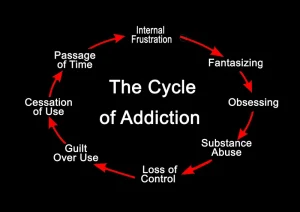Abstinence violation effect

Second, for several predictors scientific evidence for a direct association with relapse in weight loss maintenance behaviors is lacking in prior research. Therefore, to examine whether the identified perceived predictors in this study indeed predict relapse in weight loss maintenance behaviors, a larger prospective study is recommended. We suggest an ecological momentary assessment (EMA) study to track experiences over time and get insight into the process of behavior change, among which lapsing and relapsing (Shiffman, Stone, & Hufford, 2008). The current review highlights a notable gap in research empirically evaluating the effectiveness of nonabstinence approaches for DUD treatment. While multiple harm reduction-focused treatments for AUD have strong empirical support, there is very little research testing models of nonabstinence treatment for drug use. Despite compatibility with harm reduction in established SUD treatment models such as MI and RP, there is a dearth of evidence testing these as standalone treatments for helping patients achieve nonabstinence goals; this is especially true regarding DUD (vs. AUD).

Self-control and coping responses
A continuous model of change would predict that this individual returns to drinking at a proportional rate to the change in relevant risk factors. This type of model would be unable to predict the sudden fall https://ecosoberhouse.com/ from the wagon, whereby a person returns to a high level of drinking subsequent to minor changes in risk. Discontinuous change, such as the discrepancy in this example, may be better estimated using an application of nonlinear dynamical systems theory, specifically catastrophe modeling. Specific intervention strategies include helping the person identify and cope with high-risk situations, eliminating myths regarding a drug’s effects, managing lapses, and addressing misperceptions about the relapse process. Other more general strategies include helping the person develop positive addictions and employing stimulus-control and urge-management techniques.

Stopping a Slip From Becoming a Relapse
This finding demonstrates that models of the relapse process will not provide a complete description of the nonlinear dynamical process of post-treatment dinking if abstinence violation effect relapse is defined as a dichotomous event (e.g., drinking or abstaining). This finding also supports a conceptualization of treatment outcome that does not consider any drinking as a treatment failure, rather the complete, dynamic picture of the relapse process can be defined as a range of drinking outcomes. From a harm reduction perspective (Marlatt & Witkiewitz, 2002) alcohol treatment outcomes may be characterized by the severity of alcohol-related problems, not the specific quantity or frequency of drinking. Although more research on the predictors of relapse in weight loss maintenance behaviors is recommended, careful implications for practice can be made. The differences between the predictors perceived by health practitioners and those perceived by persons who regained weight may provide an opportunity to enhance lifestyle coaching, by creating more awareness of these possible discrepancies and ensuring that both points of view are included during coaching. Clients are more likely to be satisfied and follow advice on health behavior change when they feel they have been heard and understood, and are given information they recognize as relevant to them (Gable, 2007).
Social Skills Training
- As an example, when out with friends at their favorite hangout, someone with alcohol use disorder may feel like having a drink.
- While maintaining its footing in cognitive-behavioral theory, the revised model also draws from nonlinear dynamical systems theory (NDST) and catastrophe theory, both approaches for understanding the operation of complex systems 10,33.
- Outcome expectancies (anticipated effects of substance use; 27) also figure prominently in the RP model.
- Encouragement and understanding from friends, family, or support groups can help individuals overcome the negative emotional aftermath of the AVE.
Given the rapid growth in this area, we allocate a portion of this review to discussing initial evidence for genetic associations with relapse. Specifically, we focus on recent, representative findings from studies evaluating candidate single nucleotide polymorphisms (SNPs) as moderators of response to substance use interventions. It is important to note that these studies were not designed to evaluate specific components of the RP model, nor do these studies explicitly espouse the RP model. Also, many studies have focused solely on pharmacological interventions, and are therefore not directly related to the RP model. However, we review these findings in order to illustrate the scope of initial efforts to include genetic predictors in treatment studies that examine relapse as a clinical outcome.
Future research

As indicated in Figure 2, distal risks may influence relapse either directly or indirectly (via phasic processes). For instance, the return to substance use can have reciprocal effects on the same cognitive or affective factors (motivation, mood, self-efficacy) that contributed to the lapse. Lapses may also evoke physiological (e.g., alleviation of withdrawal) and/or cognitive (e.g., the AVE) responses that in turn determine whether use escalates or desists.
Integrating implicit cognition and neurocognition in relapse models
- In the treatment of eating disorders relapse often occurs in more than 20% of patients who receive treatment (Agras et al., 2000; Fichter & Quadflieg, 1999; Halmi et al., 2002).
- Self-efficacy (SE), the perceived ability to enact a given behavior in a specified context 26, is a principal determinant of health behavior according to social-cognitive theories.
- To do so, the mean importance of each perceived predictor was calculated based on the overall mean importance ratings of the underlying statements.
- He believed that drinking helped him across many domains of life (positive outcome expectancies regarding alcohol use and its effects, stage of change).
- A mindset shift caused by triggers or stress may lead you to take that drink or start using drugs again.
- As of yet, current literature still lacks an in-depth understanding of key stakeholders’ personal perspectives on relapse after weight loss.
Thus, whereas tonic processes can determine who is vulnerable for relapse, phasic processes determine when relapse occurs 8,31. Perspectives from these key stakeholders could provide new and important insights from daily practice on predictors of relapse in weight loss maintenance behaviors, which can inform future relapse prevention interventions. We therefore aimed to identify predictors of relapse in physical activity and dietary behavior, from the perspective of health practitioners who coach individuals during their weight loss process and the perspective of individuals who have experienced relapses themselves. In addition, we aimed to identify possible new predictors of relapse in physical activity and dietary behavior beyond existing knowledge, using concept mapping. Concept mapping is a structured methodology combining qualitative and quantitative methods to integrate group thought and perspectives about a particular topic, in order to produce a conceptual framework (Burke et al., 2005). Concept mapping has been applied successfully to address complex issues in health care (W. Trochim & Kane, 2005).
